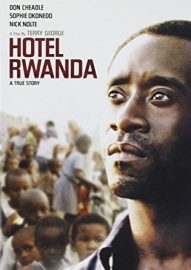Throughout this adversity unit, I’ve learned a lot about the struggles that other people can go through that I might not know about. Especially with Eleanor and Park, I learned that many things can be happening in other’s lives. We must pay attention to other people to possibly know what they are going through, then we need to help them get through their struggles. We should show the love of God through our actions towards others. Galatians 6:2 states “Carry each other’s burdens, and in this way you will fulfill the law of Christ.” Adversity can also be very hard to escape for some people. They may experience it at home as well as at school, so we need to be there for them if that could possibly be the case, even if other people don’t like us for it. We also need to remember to tell others about adversity we are facing ourselves. We can’t be isolated from society, like Eleanor was. She didn’t really tell anyone about her struggles, which resulted in them only getting worse. If she would’ve told people earlier, possibly she could’ve faced Richie and her mother with the help of people like Park, Beebi, and Denice. We also need to realize that while adversity can be big or small, it effects everyone. While I am not going through any super major adversities in my life, there are still struggles that I have to face every day. Others, however, may face larger adversities, such as Eleanor in the book. However, these adversities can effect everyone in virtually big ways. It could be one major adversity or struggle that someone is going through in their life, or it could be many large struggles that add up to make someone snap. We need to be there for people through these adversities.
Grade: High School
Disposability Essay Final Draft
Paige Trutna
Mrs. Jank
English 2
9 February 2018
The Supposed Disposability of the Disabled
In society today, many people with disabilities are seen as disposable. The mentally and physically disabled are seen as easy to throw away because of many things. Bishop John Wester states that “to overcome a throwaway culture, every person must go out into the world, encounter other people as more than commodities, and learn to treat everyone with the dignity they deserve” (Pope Francis and the Disposable Garment). Those with disabilities, especially children, are more likely to have chronic depression and be victimized by people in their lives. Women are more likely to be victims of IPV, or Intimate Partner Violence. Their supposed disposability also has an effect on the people around them; particularly parents of children with disabilities are more subject to anxiety. There are also many stories and current events that help us understand how the disabled are seen as disposable and how society can stop it. While there are many ways that people with disabilities are seen as disposable by society, there is also a side to the argument that could argue that society does not see them as disposable, because a benefit that the disabled have is health care, which allows for financial help.
The first way that the disabled can be seen as disposable by society is because depression and victimization are increasingly common in disabled children. They know that the American society often sees them as useless, so they are more prone to being depressed because of it. The Children’s Depression Inventory states that “9% of CWS (child welfare system) involved youth reported depression” (Berg 41). Depression is defined as “feelings of severe despondency and dejection.” One would argue that the key word in this definition is “severe.” Chronic depression in disabled children is not something that is just no big deal, nor should it be seen that way.
While depression is not something that should be seen as easily surmountable or minor, neither are victimizations. These victimizations are incredibly common in children with disabilities, and shows how they are, in fact, seen as disposable. The National Survey of Child and Adolescent Wellbeing proves this, saying that “24.3 percent [of children] reported one victimization, 15% reported 2, and 21.3% reported three or more victimizations” (Berg 41). These are the respective percentages of disabled children who have been abused, whether it be by an acquaintance, relative, or complete stranger. It is important to take into account that over 1/5 of disabled children in the United States have been abused three or more times. They are seen as easier to dispose of and hurt than normal children.
While depression is common in children with disabilities, anxiety is highly likely in parents of children with disabilities. This shows how people with disabilities are seen as disposable because their parents are worried about their welfare. An article by Omar A Al-Farsi, Yahya M Al-Farsi, and Samir Al-Adawi shows one that “from existing literature, it appears that psychological disorders of 15%–54% of CASD (caregivers of children with autism spectrum disorder) may be marked with symptoms of anxiety” (3). Keep in mind, this is only for parents of children with autism, but it is important to know. If these are the stats for one disability, then what do the stats look like in general? Well, “45.9% of caregivers reported for having stress and anxiety, while 48.6% reported having depression” (13-14). If society did not see disabled children as disposable, perhaps stress and anxiety of parents would not be as major of a problem. In the American society, disabled children are portrayed negatively, so parents could potentially be worried about their children being abused or made fun of at school, invoking that stress and anxiety, which can be avoided.
While feelings of depression and anxiety can potentially be avoided, so can intimate partner violence, one of the most major abuses a woman can take in her lifetime. This is also common in women with disabilities, which can just point back to how they are seen as disposable by the American society. In an article by Karen G. Langer, she states that “Violence against women has been acknowledged by the World Health Organization as a worldwide epidemic” (114). Violence against women in general has become a major problem in society, so violence against disabled women is also becoming more and more of a problem. According to the NIJ (National Institute of Justice), “approximately 25% of women endure Intimate Partner Violence during their lives” (115). This stat is for women all together, but from previous information, one can assume that the stat for disabled women, who find it harder to defend themselves, will be much higher. This article also came up with a list of reasons why disabled women could be more prone to violence. These included “increased vulnerability for abuse as increased dependability on others, violation and denial of human rights, less chance of discovery or reporting this abuse, social isolation, and increased risk of manipulation” (115-116).
Just like Intimate Partner Violence is a major problem within society, especially when it is directed toward disabled women, victimization of people with disabilities in general can be a problem. Lynda Jones, a woman with blindness, has spoken out on this issue and told her story. Jones was walking home from an internship one day in the afternoon, and she heard someone running behind her. She was confused because it was overwhelmingly hot that day, and didn’t understand why anyone would be running. However, she didn’t think much of it and continued walking home. She turned a corner and felt the runner right next to her, and she said that “in a matter of moments, I heard the jogger coming up on my right side. My first thought was perhaps I was not walking along the edge of the street. Never once did I feel endangered” (Jones, Vision Aware). However, she then felt a pulling on her purse and realized that the jogger was stealing from her. She yelled for help, and a man and his son that were watching from their apartment window came to her aid. Now, Lynda Jones leads a self defense class for the blind to ensure that no one else will have to go through what she went through. Her story just points back to how supposed disposability of disabled people is a problem in society. She was immediately targeted because she was blind, which would be much less likely to happen to someone without disabilities.
Just like Lynda Jones has spoken out about her supposed disposability, others have shared their stories about just how cruel society can be, including Nathalie Allport-Grantham and Euan McGlip. Nathalie is a woman with invisible disabilities, which, as is probably obvious, means one cannot see them. She was refused help at an airport because of her disabilities. The woman who was supposed to assist her didn’t believe she was disabled, so she was forced to pay for aid. When asked what happened, Allport-Grantham said “then she said loudly, in earshot of everyone at the gate: ‘I’ve got disabled people to help and you are wasting their time’. Everyone was staring. It was humiliating” (The Independent). Euan McGlip also shared his story. He revealed that he and his family were refused help at an Air Canada airport, even though they had a disabled son. They were forced to pay more than they should have because of mistreatment by the airport. “We explained that we had a doubly incontinent disabled child with us and that, at Air Canada’s original instruction, we only had enough sanitary and medical products to last him the expected flight plus a few hours. According to staff, this was ‘not their problem’” (McGlip). Both Nathalie and Euan show examples of how disabled people and their families are often seen as disposable or useless by society because of how people treat them. Even though they are clearly disabled and need help, people refuse to help them because of their struggles.
While the majority of arguments are that disabled people are often seen as disposable by American society, there are some things that prove that they do have help possible. Both the Social Security and Supplemental Security Income programs have financial aid for people with disabilities, along with many help programs across the country. The Social Security system gives financial benefit to disabled people with insurance. “Social Security Disability Insurance pays benefits to you and certain members of your family if you are “insured,” meaning that you worked long enough and paid Social Security taxes” (Benefits for People with Disabilities). The Supplemental Security Income system also helps with financial aid. If desperately needed, the SSI will give the disabled person and/or their family money, depending on how much is needed. Both of these programs argue against the supposed disposability of disabled people.
In conclusion, people with disabilities are mostly seen as disposable by the American society today. This can be seen in depression and victimization in children with disabilities. Children with disabilities are worried about what people think of them, so they are more prone to feelings like this. Anxiety in parents with disabled children is also common. They are concerned about how their children are being treated, especially at school, invoking these feelings. Women also have an increased risk of IPV, because of their increased vulnerability. There are also stories about different people who have shared about their disabilities, which proves that disabled people are more likely to be seen as disposable by society. However, one can argue that disabled people do have help spread across the country, especially in the Social Security and Supplemental Security Income systems. All of these points are reasons that disabled people are seen as disposable by society.
Works Cited
Berg, K. L.; Shiu, C.-S.; Msall, M. E.; Acharya, K. Child: Care, Health & Development. Nov2015, Vol. 41 Issue 6, p989-999. http://search.ebscohost.com/ login.aspx?direct=true&db=cmh&AN=111382444
Julia Buckley. “Disabled woman “humiliated” by Airport Employee who Refused Assistance.” The Independent. 2 January 2018.
http://www.independent.co.uk/travel/news-and-advice/disabled-woman-stansted- airport-refuse-help-ryanair-nathalie-allport-grantham-a8138051.html
Carman, Linda. Perspectives in Psychiatric Care. May2006, Vol. 42 Issue 2, p114-129. 16p. http://search.ebscohost.com/login.aspx. direct=true&db=cmh&AN=20466176
Lynda Jones. Vision Aware. ND. http://www.visionaware.org/info/emotional-support/ personal-stories/crime-and-domestic-violence-stories/violent-crime-against- people-who-are-blind/1235
Langer, Karen G. “Depression and Denial in Psychotherapy of Persons with Disabilities.” American Journal of Psychotherapy, vol. 48, no. 2, Spring1994, p. 181. EBSCOhost, http://search.ebscohost.com/login.aspx? direct=true&db=f6h&AN=9411171210
Social Security website. ND. NA. https://www.ssa.gov/disability/
Neuropsychiatr Dis Treat. 2016; 12: 1943–1951. Published online 2016 Aug 4. doi: 10.2147/NDT.S107103. https://pwww.ncbi.nlm.nih.gov/pmc/articles/ PMC4977076/
Source 5: Benefits for People with Disabilities
This source is very helpful for seeing the other side of the argument. While most of my paper will be about how society sees disabled people as disposable, this website talks a lot about how people with disabilities do have some benefits, some of the main ones being financial and health help. This website’s thesis or claim states that “The Social Security and Supplemental Security Income disability programs are the largest of several Federal programs that provide assistance to people with disabilities.” Both of these programs help people with disabilities to be more a part of society, instead of being seen as disposable, as they are now. In my paper, I definitely plan on using this source. I think it will help me to get the reader to see both sides of the story for disabled people.
Source 4: Blind Woman Walking Home
This source is a story about a blind woman who was walking home from her internship, when she got attacked by a “jogger” in the street. This story is written by Lynda Jones, and was found in the Vision Aware website. She said that “In a matter of moments, I heard the jogger coming up on my right side. My first thought was perhaps I was not walking along the edge of the street. Never once did I feel endangered.”. This proves that sometimes, disabled, in this case blind, people don’t always feel endangered, but when something happens, they are forced to feel this way. I plan on using this source in my paper to lead into blind people and disabilities. This story will help me to expand my horizons in my paper to not only bodily disabled people, but visually disabled too.
Source 3: Story About Woman Refused Help at Airport
This source is a true story about a woman, Nathalie Allport Grantham, who “has branded Stansted Airport staff “disgusting” after she was denied assistance because she “didn’t look disabled”.” She was refused help onto a plane at the airport because her disablilities were invisible, in other words, they were inside her body. Nathalie has Ehlers-Danlos syndrome, which means she suffers from joint pain. The helper at the airport said that if she wanted assistance, she would’ve had to pay like everyone else. In this article, Nathalie Allport Grantham is interviewed and gave her point of view on the issue. She told her story, then said that “then she said loudly, in earshot of everyone at the gate: ‘I’ve got disabled people to help and you are wasting their time’. Everyone was staring. It was humiliating.” I plan on using this as an example of how disabled people are seen as disposable by society.
Source 2: Victimization and Depression in Youth With Disabilities
I took this source’s main claim and thesis to be that “Youth with disabilities in the United States in the Child Welfare System are at high risk of experiencing victimization and clinical depression” (989). The author of this paper is K.L. Berg, and it was written in November 2015, in a journal about Health and Wellness. This source used a lot of studies and information in their paper. I plan on using this source for its stats and variety. It has information from the National Survey of Child and Adolescent Wellbeing and the Children’s Depression Inventory. It also has many interviews with children, with the average age being about 13.5. My other source was mainly focused on women with disabilities and how they are at risk for Intimate Partner Violence, but this one is focused on children and how they are at risk for depression because of their disability.
Source 1: Partner Abuse in Disabled Women
This source’s claim is saying that “women who are at increased risk for intimate partner violence: women with disabilities.” This article is written by Karen G. Langer in the American Journal of Psychotherapy. She uses many sources in her article, including books, other articles, and some studies, including one from Baylor, and one from the Center of Disease Control and Prevention. One quote that I think represents what this article is talking about says that a couple people “identified some of the reasons for increased vulnerability for abuse as increased dependency on others, violation and denial of human rights, less chance of discovery or reporting the abuse, social isolation, and increased risk of manipulation” (115). I plan on using this source for stats, quotes, and many other things. Because of all the studies that are included in the paper, this source has plentiful information that can be useful to making my point in my paper.
Hotel Rwanda Reaction
I thought that Hotel Rwanda was a very good choice of movie to watch to learn about disposability. There were many people who were disposed of or thrown away in this movie, whether they were Tutsis, Hutus, or even foreign helpers. By the society of Rwanda and the society of the rest of the world, both of these cultures were thrown away. They were seen as useless, or at least only useful when they had completed their job, and weren’t needed anymore. After this, they were killed or injured because they couldn’t be used and manuipulated by other people anymore.
I also thought that this movie was very eye opening. I won’t say I was completely unaware of bad things going on in the world, but I also won’t say I was aware of things like this happening, and people (even Americans) not helping. The fact that things like this go on and we can do something about it, but don’t, worries me. I think that if people can help other people survive, they should. This movie was also eye opening for me in seeing how violent people can be towards others who are different. They are not afraid to hurt people who they don’t agree with.
We’ve also had other conversations in class which I think are important to acknowledge. The main thing we talked about is other groups of people who were seen as disposable by society. Pope Francis listed off a few groups, including the sick, disabled, poor, young, and even something like the internet. I agreed with the majority of them, but the internet is something I saw as very non-disposable. We value the internet more than we value other people in our lives sometimes, at least that’s how I see it. The articles we’ve read, things we’ve talked about, and movies we’ve watched have really helped understand the concept of disposability.
Semester Reflection
Throughout this semester, I think I’ve grown a lot as a student in the areas of reading, writing, speaking, and thinking. There were many units that helped me grow in these areas, some of the main ones being our informative speeches and choice reading and writing.
When we did informative speeches, I chose the topic of photography, mostly because I wanted to learn more about it myself. When doing this speech, I was taught how to successfully talk in front of people and get them to listen to me. I think that the information I derived from this speech is going to help me in years to come. Some of the main things I learned: don’t talk too fast, connect your speech to the visual aid, show more emotion, make sure to be loud, and gesture along with your words.
The choice reading and writing unit really helped me with my reading and writing (obviously), but also with my thinking skills. When I read The Sun is Also a Star, I learned how to read a book and understand what was going on so that I could relate to the characters and the plot, and I also learned how to think like the characters and even to think in ways I had never thought possible before. When I read this book, my reading and thinking skills went up a level purely because of the writing style and what I had to do to stay involved with the book.
During the choice reading and writing unit, I also learned many things about writing. One of the main things is not to rush the ending, even if your story does end up being a little longer than what you expected. If you want the story to end up like you were imagining, you have to take the time to develop the plot and the characters how they should be developed. You also can’t rush the ending. The end is one of the most important parts of the story, as it is when everything is resolved (most of the time). You could write an amazing story, but if the ending isn’t good, all that could go down the drain, so you can’t rush the ending. Just like you have to take time to develop the characters and plot, you have to take time to develop the ending and make it the way you want.
Annotated Bibliography on Abortion
Paige Trutna
Mrs. Jank
Interpersonal Communications
12/14/17
Topic: Should abortion be legal or illegal in the United States?
Claim: Many people on the pro-life side argue that abortion should not be legal in the United States because it is murder, and there are many other options if you don’t think you are able to take care of a child.
Annotated Bibliography
Should Abortion Be Legal? Abortion Procon Website. https://abortion.procon.org. N.D.
This website gives reasons for both of the sides in this debate, and it stated that the 14th amendment says depriving “any person of life, liberty, or property, without due process of law.” This website talks about the pros and cons of abortion, which I feel could help with our arguments. It uses many examples from different points of view, like morality, government, and legality. There aren’t many limitations with this source, because they are not very biased (given that they have both sides) and they use many sources. We feel that this website can help strengthen our arguments because it talks about both the legality and the morality of abortion and the pro-life side.
Alcorn, Randy. 39 Major Pro-Choice Arguments and Their Refutations. Eternal Perspective Ministries. http://www.epm.org/resources/2010/Feb/18/39-major-prochoice-arguments-and-their-refutations/. Feb. 18, 2010.
On this website, the author is listing pro-choice arguments and explaining how prolifers can refute them. This article is an excerpt from a book written by Randy Alcorn. He is arguing that the pro-life side is correct. To support this argument, he has many examples of things the pro-choice side has argued, and how it is possible to refute them. This source has some limitations- bias and lack of other sources. However, these can be overlooked, given that the author is a published writer. In our debate, we will use the different arguments in this article to refute the other side and make ours stronger. This will be a good source to allow us to see what the other side could potentially argue, and how we could possibly refute it.
The Prolife Argument. The University of Colorado Boulder. https://www.colorado.edu/studentgroups/studentsforlife/argument.html. N.D.
This website talks about the pro-life argument from an objective point of view. It is from the University of Colorado Boulder, which means it is probably reviewed and valid. The authors of this paper aren’t really making an “argument” so to speak, because it is objectively written. However, I think this can be useful. If it is objective, then it allows people to see the pro-life side without forcing it on them. The potential limitation is its objectivity. There are also very good things about this source. It is non-biased, it cites its information, and it is from an official university. The general ideas found in this article about the pro-life argument could be very useful in our presentation. We will be able to provide the audience with information about what we are arguing and why it is relevant.
Brind, Joel. Abortion- Breast Cancer Link [ABC link]: Review of Recent Evidence from Asia. http://web.b.ebscohost.com/ehpl/pdfviewer/pdfviewer?vid=6&sid=5cf939e0-949a-486a-bfeb-08a628722636%40sessionmgr103. Sept. 1, 2017.
This source talks about the potential link between breast cancer and abortions. It states that women who have 1 or more abortions are 160% more likely to have breast cancer. This was recently proven in Asia, and although it is not the United States, it could be very prevalent here. This article was written by Joel Brind, a PHD. He is a qualified person to talk about this issue, because he has a PHD in issues like this. This source also cites its information, and it has many credible sources. It has many info graphics, data sets, and images that allow us to understand the information better. It is a peer-reviewed source, which makes it valid and relevant to the topic. This source has no limitations. Because the source talks about the link between breast cancer and abortions, it will be a good source to use in our presentation about why abortion is negative.
Stewart, Amelia. The Economics of Abortion. Adam Smith Institute. https://www.adamsmith.org/blog/the-economics-of-abortion. N.D.
This source talks about the link between economics and abortions. One of the main points that would be useful in our argument is “Since legalization, the overall birth rate fell by 5% in the US…”. This talks about how since abortion was legalized, birth rate has gone down, so our country isn’t as prominent with people. 5% might not seem like much, but when I did the math, it ended up to be 16, 205, 939 people. That’s a lot of people that could’ve helped in the future. One limitation of this source is its lack of other sources. It doesn’t have any other websites or articles cited. However, it has some strong suits. It isn’t very biased, and it has a lot of data to back up its points. I think that in our presentation, this website could be very useful in bringing up the economics of abortion, along with the legality and morality. I think that with this source, we have a lot of areas covered.
Preliminary Research:
http://www.frc.org/brochure/the-best-pro-life-arguments-for-secular-audiences
https://www.thoughtco.com/arguments-for-and-against-abortion-3534153
https://prolifetraining.com/resources/five-minute-1/
https://www.huffingtonpost.com/entry/five-ways-to-actually-be-pro-life-based-on-evidence_us_58f94350e4b086ce58980f52






